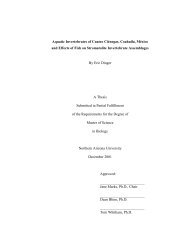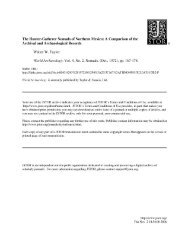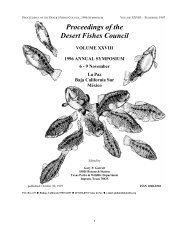Proceedings of the Desert Fishes Council 2000
Proceedings of the Desert Fishes Council 2000
Proceedings of the Desert Fishes Council 2000
Create successful ePaper yourself
Turn your PDF publications into a flip-book with our unique Google optimized e-Paper software.
PROCEEDINGS OF THE DESERT FISHES COUNCIL - VOLUME XXX1I (<strong>2000</strong> SYMPOSIUM) – PUBLISHED NOVEMBER 13, 2001<br />
RESUMEN<br />
Estructura de la comunidad y dinámica de la trama trófica en Devils Hole, Nevada<br />
Se realizaron estimaciones de carbono alóctono y autóctono en Devils Hole, Nevada [EUA] con el fin de<br />
determinar su importancia estacional en la dieta del cachorrito de Devils Hole, Cyprinodon diabolis, especie en<br />
peligro. Los análisis de la dieta y de isótopos estables también se utilizaron para analizar la variabilidad<br />
estacional de las fuentes de carbono para C. diabolis. Se hizo un monitoreo continuo de la energía solar y se<br />
colectaron trampas de desecho (entrada de alóctonos) a intervalos de cuatro semanas durante un año. Se registró<br />
la composición y biomasa de algas e invertebrados cada dos meses, así como la productividad primaria y el<br />
metabolismo total del ecosistema. Los vegetales terrestres representaron casi 57% de la entrada anual de<br />
alóctonos, con máximos registrados en diciembre y abril. La composición estacional y la biomasa de carbón<br />
alóctono mostró una relación directa con la entrada de energía solar. El rango de la energía luminosa diaria<br />
durante el verano, con máximo de tres horas de luz directa, fue de 200 mE/m 2 /s a 1,350 mE/m 2 /s comparado<br />
con un máximo de tan sólo 30 mE/m 2 /s durante el invierno cuando el sistema no recibió luz directa. En verano<br />
la biomasa media de algas fue de 24.5 g AFDM/m 2 (SE ± 6.4), compuesta de densos tapetes de cianobacterias y<br />
de filamentos de Spirogyra sp., en tanto que en invierno la biomasa media fue de 5.5 g AFDM/m 2 (± 2.5) y se<br />
componía sobre todo de diatomeas y de Oscillatoria spp. La biomasa media anual de invertebrados fue de 0.47 g<br />
AFDM/m 2 (± 0.04) y estuvo dominada por el caracol Tryonia variegata. La dieta de C. diabolis mostró gran<br />
cantidad de cristales de carbonato, detritus y diatomeas. El análisis de los contenidos estomacales mostró<br />
también la presencia de unos cuantos especimenes de Stenelmis calida, Liodessus affinis, T. variegata, y<br />
Hyalella sp. en el 30% de los peces examinados. El análisis preliminar de múltiples isótopos estables mostró la<br />
depleción de d13C de octubre de 1999 a febrero de <strong>2000</strong>. En octubre el rango de valores fue de -28.5 a -24.5<br />
ppm, mientras que en febrero el rango fue de -29 a -31 ppm. Esto sugiere que C. diabolis utiliza diferentes<br />
fuentes de carbono a lo largo del año. Se discute las implicaciones del estatus trófico del gusano plano Dugesia<br />
dorotocephala en la población del cachorrito.<br />
Modde, T 1 ; Crist, L 2<br />
(1-U.S. Fish and Wildlife Service; 2-U.S. Bureau <strong>of</strong> Reclamation)<br />
Upper Colorado River Basin area report<br />
ABSTRACT<br />
During 1999-<strong>2000</strong> several flow recommendations were approved or are in <strong>the</strong> development stage at this<br />
writing for several Upper Colorado River tributaries. A syn<strong>the</strong>sis <strong>of</strong> a five-year-flow study on releases from<br />
Flaming Gorge Dam was completed by <strong>the</strong> recovery program which summarized most <strong>of</strong> <strong>the</strong> existing<br />
information on <strong>the</strong> large river fishes in <strong>the</strong> Green River subbasin. This document provided flow<br />
recommendations for each season for each <strong>of</strong> three reaches <strong>of</strong> <strong>the</strong> river (Lodore Canyon, confluence <strong>of</strong> <strong>the</strong><br />
Yampa River to <strong>the</strong> confluence <strong>of</strong> <strong>the</strong> White River, and from <strong>the</strong> confluence <strong>of</strong> <strong>the</strong> White River to <strong>the</strong> confluence<br />
<strong>of</strong> <strong>the</strong> Green and Colorado rivers). A flow recommendation was also prepared for releases from <strong>the</strong> Aspinall<br />
units on <strong>the</strong> Upper Colorado River. These documents will serve as <strong>the</strong> template for revised biological opinions<br />
on <strong>the</strong> operation <strong>of</strong> dams on both rivers. The flow recommendations will alter <strong>the</strong> current operations <strong>of</strong> both<br />
systems, and <strong>the</strong> Bureau <strong>of</strong> Reclamation is in <strong>the</strong> process <strong>of</strong> preparing an Environmental Impact Statement for<br />
each revised biological opinion. A programmatic biological opinion was prepared for <strong>the</strong> 15-mile reach on <strong>the</strong><br />
Colorado River, and ano<strong>the</strong>r is being prepared for <strong>the</strong> Yampa River that will based on a Yampa Valley<br />
Management plan. The latter incorporates nonnative management actions toge<strong>the</strong>r with annual flow<br />
recommendations. Proposed recovery goals for <strong>the</strong> large Colorado River fishes will be submitted by Fish and<br />
Wildlife Service to <strong>the</strong> federal register in September (tentative date). Development <strong>of</strong> recovery goals was<br />
initiated through Region 6 <strong>of</strong> <strong>the</strong> Fish and Wildlife Service. Several workshops and meetings within <strong>the</strong> Upper<br />
Basin recovery program and recovery team provided input to <strong>the</strong> document, however, consensus among all<br />
participants was not achieved. Augmentation highlights in <strong>the</strong> Upper Colorado River Basin included <strong>the</strong> first<br />
reintroduction <strong>of</strong> bonytail, Gila elegans, into <strong>the</strong> state <strong>of</strong> Colorado. Five thousand fish were stocked in both <strong>the</strong><br />
Yampa (just upstream from <strong>the</strong> Green River confluence) and <strong>the</strong> Green River (upstream <strong>of</strong> Lodore Canyon).<br />
Bonytail has been stocked in <strong>the</strong> lower Green River in Utah during <strong>the</strong> last three years. Razorback sucker,<br />
7



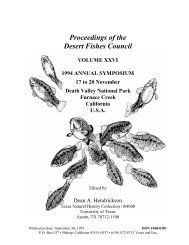
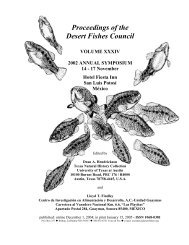
![Part 2 [419KK] - Desert Fishes Council](https://img.yumpu.com/14712282/1/190x245/part-2-419kk-desert-fishes-council.jpg?quality=85)

